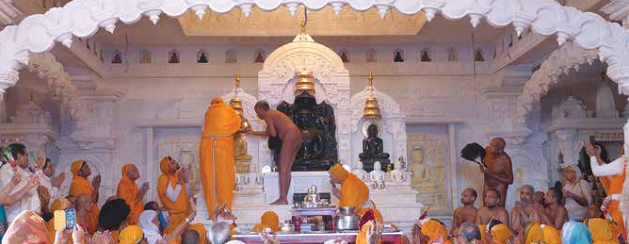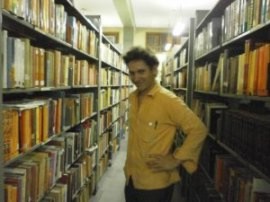
Centre of Jaina Studies Newsletter: SOAS - University of London
From 15 to 19 July 2015, the University of Lausanne, Switzerland hosted the 12th International Conference on Early Modern Literatures in North India (ICEMLNI). The conference was organised by Maya Burger and Nadia Cattoni on their spacious and green campus close to the shores of the idyllic Lac Léman. The triennial ICEMLNI intends to bring together specialists of North Indian languages and literatures. Formerly colloquially known as 'the Bhakti conference', earlier editions focused mostly on bhakti literature written in early Hindi. With the explicit aim of pursuing comparative insights, the conference in its more recent editions has widened its scope. Yet, so far only very few papers on Jainism had been read at these conferences. For the first time the 2015 conference included a panel devoted entirely to Jainism. While introducing the panel, chairperson Daniel Gold (Cornell University) remarked that no understanding of the early modern period, be it from a literary, religious or historical perspective, could be complete without attention to the contributions of the Jains, as constituting important communities in for example Western India. John Cort (Denison University), the first to come to the dais to present his paper, added that the Jains, contrary to what is often presumed, not merely borrowed from other traditions, but themselves often exercised crucial and initiatory influence upon others. It was precisely in this line of thought that, during discussion rounds throughout the conference, the participants much appreciated comparative perspectives and elucidations on various issues from the Jain side of things.
In his paper titled '"No One Gives Like the Guru": Devotion to the True Guru in Digambar Hindi Literature', John Cort discussed Jain Brajbhāṣā authors such as Dyānatray (1676-1726 CE), Bhūdhardās (dated works from 1724-44 CE) and Banārsīdās (1587-1643 CE), and their expressions of the nature of the supreme guru. In compositions that were widespread and are still well-known today, such as Bhūdhardās' Bandauṃ digambar and Banārsīdās' Sādhu Vandan, Cort noted the focus on the naked muni as an ideal guru. Elements of eager petitioning (vinatī) and the agony of separation (viraha) of the guru in this poetry reflect the historical fact that naked renouncers remained a largely unseen ideal throughout most of the early modern period. By contrast, in compositions of the early 20th century we see the criticism of the clothed bhaṭṭārakas as false gurus (kuguru) taking far more stringent forms, while at the same time, as naked munis reappeared, poems began to be written in a spirit of rejoicing about the (re)union with the true guru.
The next contribution, by the present writer (Tillo Detige, Ghent University), offered a complementary perspective through its focus on 'Ascetic Ideals & Gurubhakti in the Bhaṭṭāraka lineages of Digambara Jainism'. Here, today little-known 15th to 18th-century devotional and ritual texts (gīta, pūjā, etc.) were analyzed in which individual bhaṭṭārakas, or sometimes even bhaṭṭāraka lineages in their entirety, stand as the object of veneration. Attention was raised to their rich, ethical, soteriological and ontological contents, and their mnemonic structures. It was argued that these texts and the practices in which they were performed constituted an epistemological tool for the transmission and embodiment of values of renunciation, as a fundamental Jain 'technology of the self'. Other vernacular, literary texts from the early modern period testify to the conferment of the ascetic ranks of muni, upādhyāya and ācārya to renouncers in the bhaṭṭāraka saṅghas, and the parallels of the bhaṭṭāraka dīkṣā with contemporary muni consecration rituals. Like the enduring practices of veneration of historical renouncers, these latter findings too speak of continuities right across the early modern period, and thus challenge the idea of a distinct 'bhaṭṭāraka era'.
The third contribution to the panel was Steven Vose (Florida International University)'s paper 'Jain Language Use in Early Modern Western India: Examining the Trajectory of Tellings of the Narmadāsundarī Satī Kathā'. Vose provided a summary of the contents of this śīla kathā-type narrative on the unfathomable mechanisms of karma and the ideal, virtuous conduct of a Jain woman. He subsequently compared three versions of the story, a 12th-century Prakrit text by Mahendrasūri in mixed verse and prose with kāvyaesque embellishments and elaborations; the Namaya sandhi, a 13th-century versified Apabhraṃśa version by Jinaprabhāsūri of the Āgama Gaccha, and a 15th-century prose telling in Old Gujarati by Merusundaragaṇi. Vose argued that the choice of language, instead of merely and solely corresponding to natural language development, was determined by the registers and genres the authors sought to work in, while the choice of the latter in turn depended on their purposes. The development of the vernacular did not efface the use of classical languages altogether; the former, in other words, did not supplant the latter all at once, but long remained a genre-specific option.
Vose concluded the panel with a general remark on the nature of Jain identities in the early modern period which carries great bearing. While notions of 'Hindu' and 'Muslim' identity as fixed, trans-historical categories have long been challenged, Jains all too often continue to be conceived of as a distinct, homogenous social group. Here, a pan-Jain consciousness, which developed only in the modern and contemporary period, is read into earlier contexts. While in certain situations Jains of various affiliations might indeed have considered each other as 'co-religionists', far more often maybe not only Śvetambara and Digambara but also further caste and gaccha variations and idiosyncratic practices defined the actual social and 'religious' boundaries. An improved understanding of and sensitivity to such differentiations seems necessary not solely for its higher historical accuracy, but also to connect developments within these various Jain traditions and contexts more closely and more specifically to non-Jain partners and counterparts.
Considering the prodigious literary production by Jains in the early modern period, the amount of unstudied, unedited and untranslated materials lying dormant in Jain manuscript collections, and the reality of complex, rhizomatic influences and parallel developments between various Indian traditions, it can be hoped that more work in this field, era and paradigm will be forthcoming. Future ICEMLNI conferences will continue to offer an inspiring and invigorating environment to connect materials and insights from the Jain traditions to broader developments in North Indian literary and religious traditions of the early modern period, and vice-versa. The 13th ICEMLNI conference is scheduled to take place at the University of Warsaw in the summer of 2018.
Tillo Detige (Ghent University) is currently working on a PhD as part of the research project: Early Modern Digambara Jainism in Western India: The Age of the Bhaṭṭārakas?

Elācārya Prajñāsāgara directs a layman performing abhiṣeka at the conclusion of the consecration of the Digambara Jaina Ratnatraya Jina Mandira,
Dvārakā (Delhi), 12th of February 2014. (Photo: Tillo Detige)
 Tillo Detige
Tillo Detige